Assignment on Accounts - The Profit and Loss Statement
VerifiedAdded on 2022/08/24
|11
|2249
|20
AI Summary
Contribute Materials
Your contribution can guide someone’s learning journey. Share your
documents today.
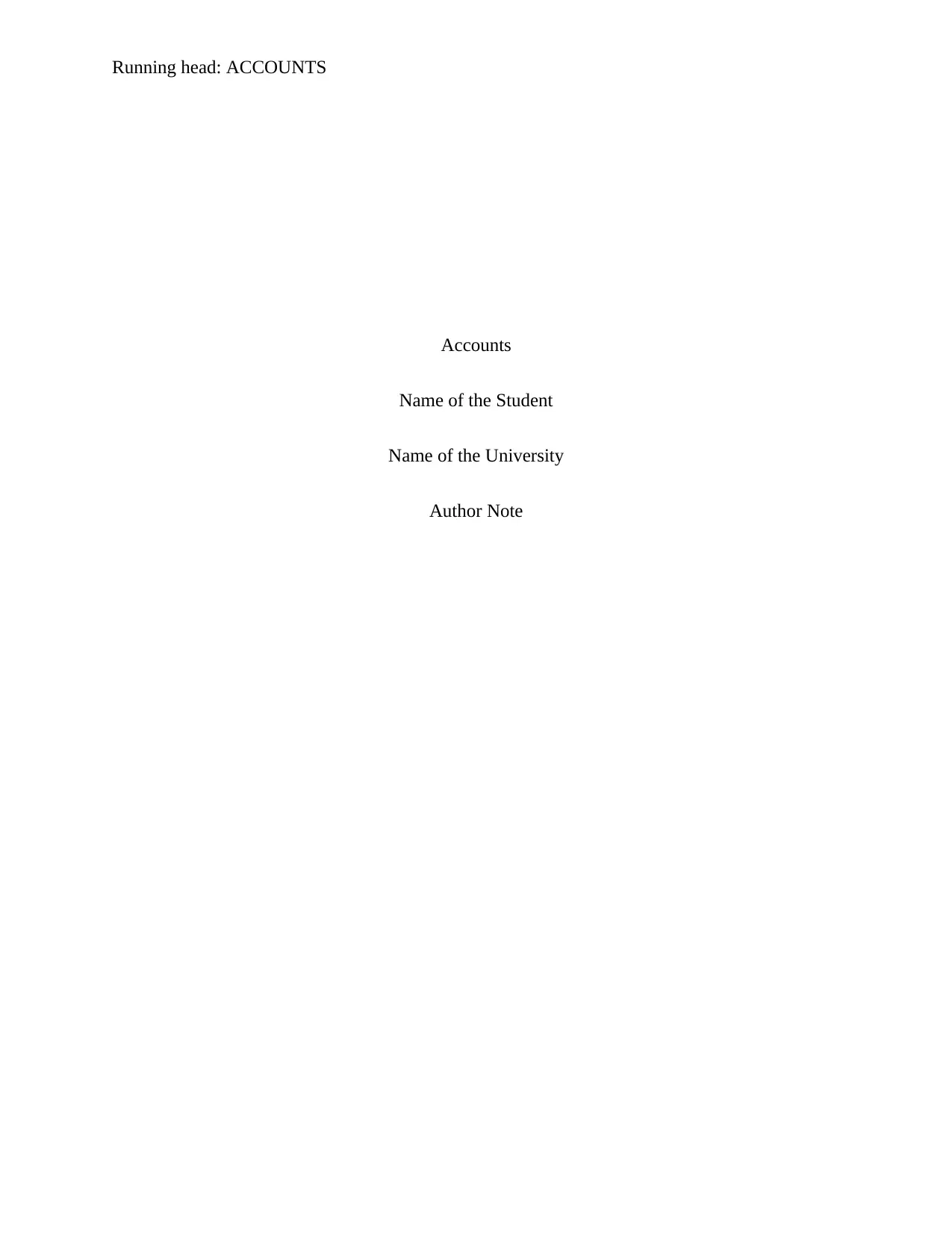
Running head: ACCOUNTS
Accounts
Name of the Student
Name of the University
Author Note
Accounts
Name of the Student
Name of the University
Author Note
Secure Best Marks with AI Grader
Need help grading? Try our AI Grader for instant feedback on your assignments.
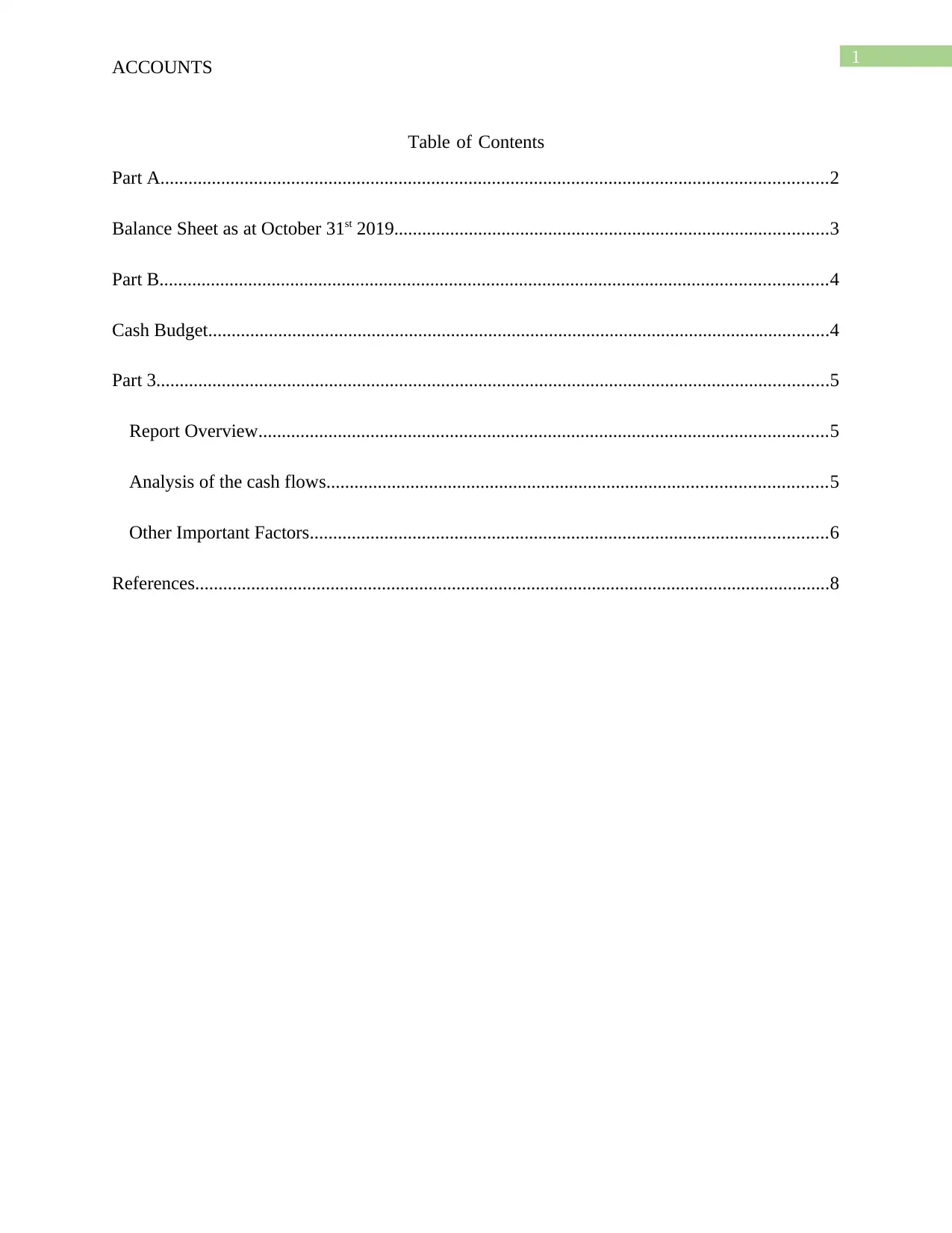
1
ACCOUNTS
Table of Contents
Part A...............................................................................................................................................2
Balance Sheet as at October 31st 2019.............................................................................................3
Part B...............................................................................................................................................4
Cash Budget.....................................................................................................................................4
Part 3................................................................................................................................................5
Report Overview..........................................................................................................................5
Analysis of the cash flows...........................................................................................................5
Other Important Factors...............................................................................................................6
References........................................................................................................................................8
ACCOUNTS
Table of Contents
Part A...............................................................................................................................................2
Balance Sheet as at October 31st 2019.............................................................................................3
Part B...............................................................................................................................................4
Cash Budget.....................................................................................................................................4
Part 3................................................................................................................................................5
Report Overview..........................................................................................................................5
Analysis of the cash flows...........................................................................................................5
Other Important Factors...............................................................................................................6
References........................................................................................................................................8
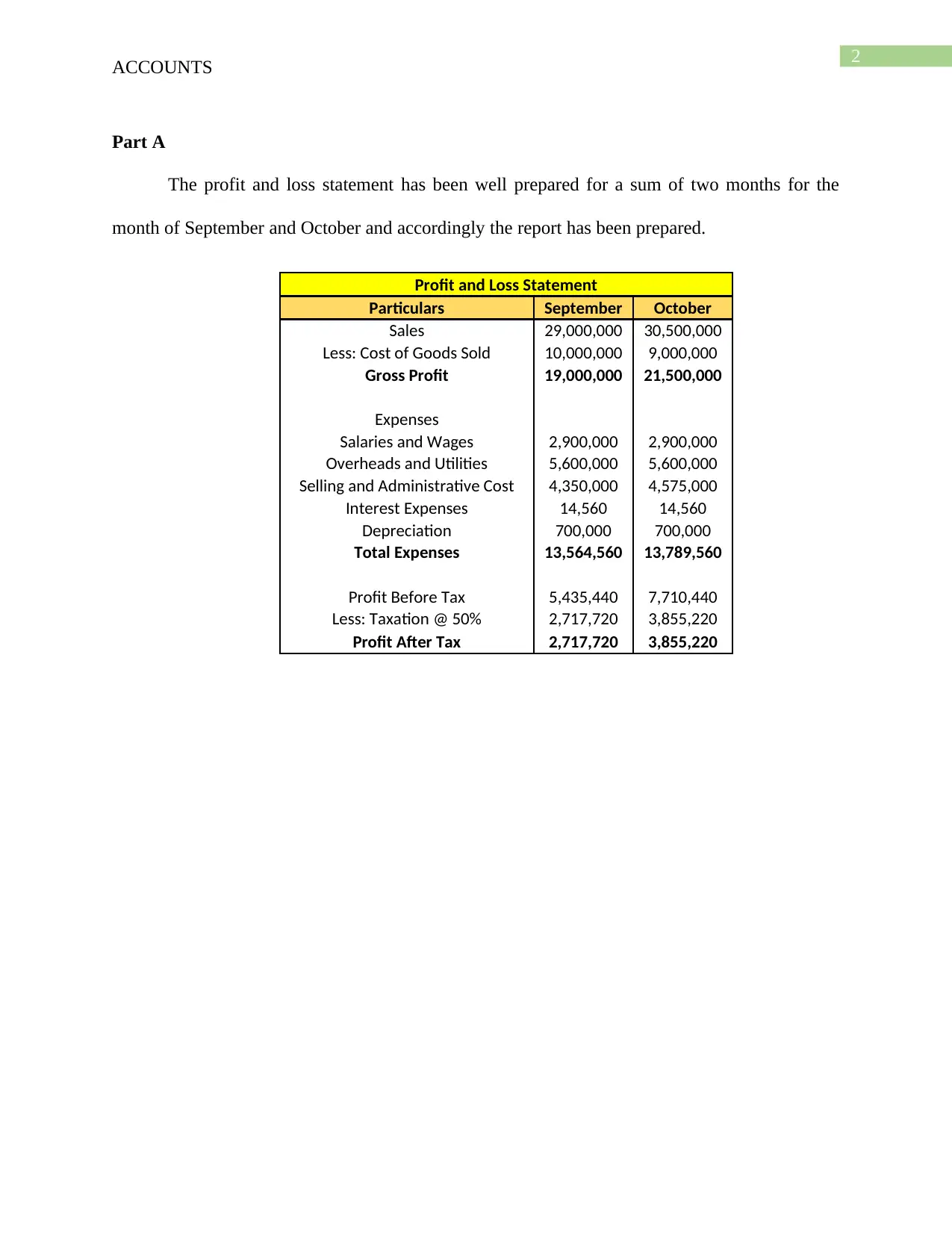
2
ACCOUNTS
Part A
The profit and loss statement has been well prepared for a sum of two months for the
month of September and October and accordingly the report has been prepared.
Profit and Loss Statement
Particulars September October
Sales 29,000,000 30,500,000
Less: Cost of Goods Sold 10,000,000 9,000,000
Gross Profit 19,000,000 21,500,000
Expenses
Salaries and Wages 2,900,000 2,900,000
Overheads and Utilities 5,600,000 5,600,000
Selling and Administrative Cost 4,350,000 4,575,000
Interest Expenses 14,560 14,560
Depreciation 700,000 700,000
Total Expenses 13,564,560 13,789,560
Profit Before Tax 5,435,440 7,710,440
Less: Taxation @ 50% 2,717,720 3,855,220
Profit After Tax 2,717,720 3,855,220
ACCOUNTS
Part A
The profit and loss statement has been well prepared for a sum of two months for the
month of September and October and accordingly the report has been prepared.
Profit and Loss Statement
Particulars September October
Sales 29,000,000 30,500,000
Less: Cost of Goods Sold 10,000,000 9,000,000
Gross Profit 19,000,000 21,500,000
Expenses
Salaries and Wages 2,900,000 2,900,000
Overheads and Utilities 5,600,000 5,600,000
Selling and Administrative Cost 4,350,000 4,575,000
Interest Expenses 14,560 14,560
Depreciation 700,000 700,000
Total Expenses 13,564,560 13,789,560
Profit Before Tax 5,435,440 7,710,440
Less: Taxation @ 50% 2,717,720 3,855,220
Profit After Tax 2,717,720 3,855,220
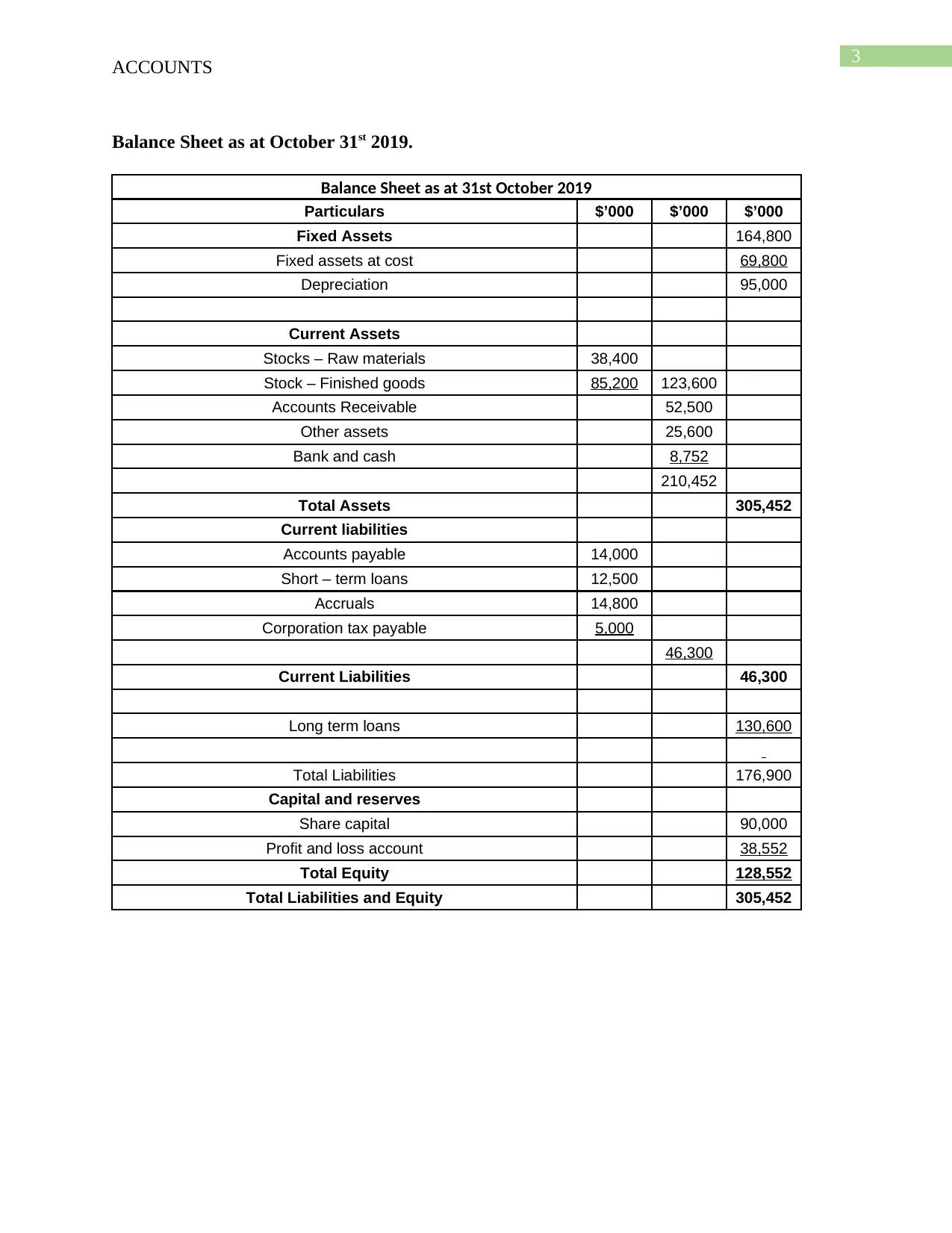
3
ACCOUNTS
Balance Sheet as at October 31st 2019.
Balance Sheet as at 31st October 2019
Particulars $’000 $’000 $’000
Fixed Assets 164,800
Fixed assets at cost 69,800
Depreciation 95,000
Current Assets
Stocks – Raw materials 38,400
Stock – Finished goods 85,200 123,600
Accounts Receivable 52,500
Other assets 25,600
Bank and cash 8,752
210,452
Total Assets 305,452
Current liabilities
Accounts payable 14,000
Short – term loans 12,500
Accruals 14,800
Corporation tax payable 5,000
46,300
Current Liabilities 46,300
Long term loans 130,600
Total Liabilities 176,900
Capital and reserves
Share capital 90,000
Profit and loss account 38,552
Total Equity 128,552
Total Liabilities and Equity 305,452
ACCOUNTS
Balance Sheet as at October 31st 2019.
Balance Sheet as at 31st October 2019
Particulars $’000 $’000 $’000
Fixed Assets 164,800
Fixed assets at cost 69,800
Depreciation 95,000
Current Assets
Stocks – Raw materials 38,400
Stock – Finished goods 85,200 123,600
Accounts Receivable 52,500
Other assets 25,600
Bank and cash 8,752
210,452
Total Assets 305,452
Current liabilities
Accounts payable 14,000
Short – term loans 12,500
Accruals 14,800
Corporation tax payable 5,000
46,300
Current Liabilities 46,300
Long term loans 130,600
Total Liabilities 176,900
Capital and reserves
Share capital 90,000
Profit and loss account 38,552
Total Equity 128,552
Total Liabilities and Equity 305,452
Secure Best Marks with AI Grader
Need help grading? Try our AI Grader for instant feedback on your assignments.
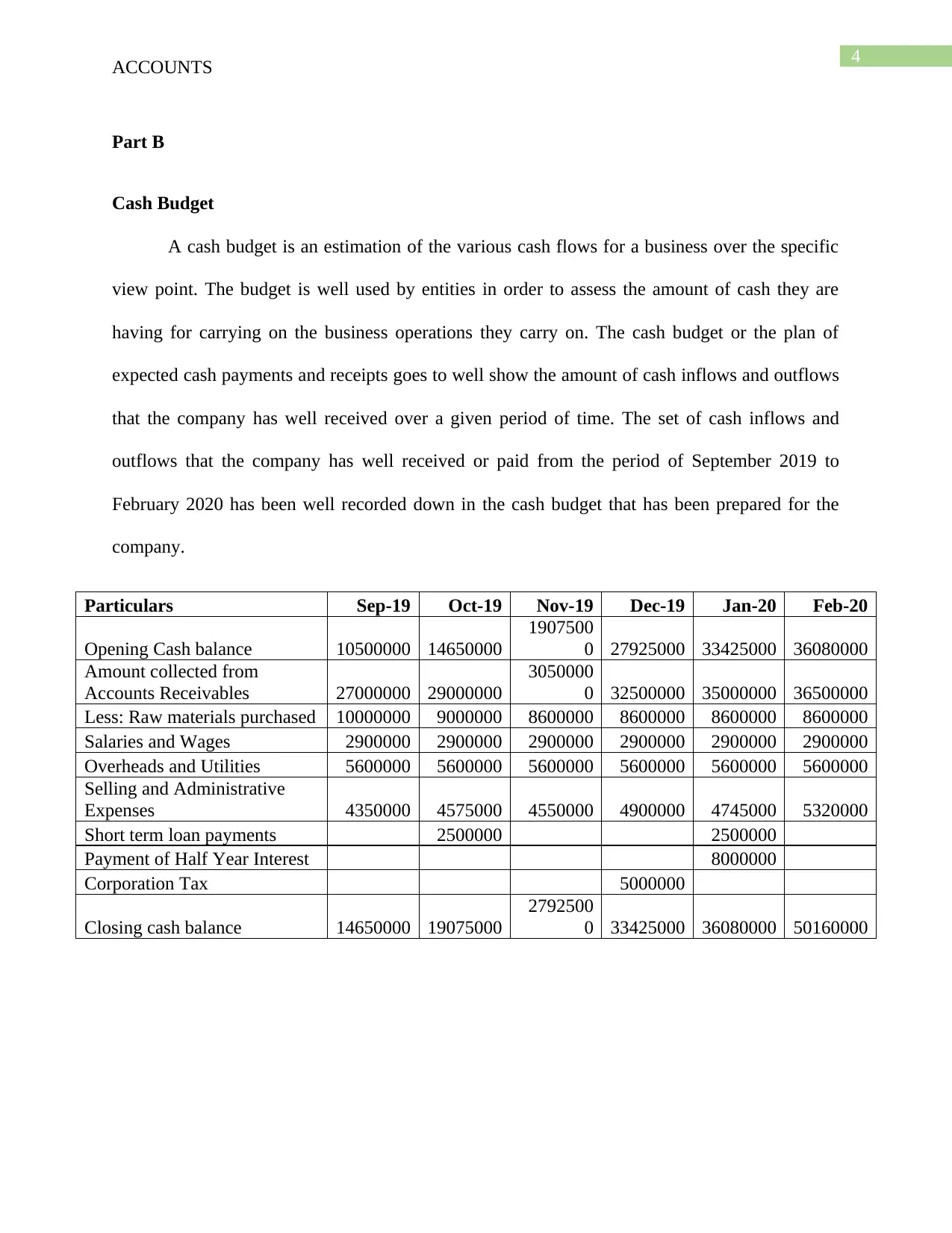
4
ACCOUNTS
Part B
Cash Budget
A cash budget is an estimation of the various cash flows for a business over the specific
view point. The budget is well used by entities in order to assess the amount of cash they are
having for carrying on the business operations they carry on. The cash budget or the plan of
expected cash payments and receipts goes to well show the amount of cash inflows and outflows
that the company has well received over a given period of time. The set of cash inflows and
outflows that the company has well received or paid from the period of September 2019 to
February 2020 has been well recorded down in the cash budget that has been prepared for the
company.
Particulars Sep-19 Oct-19 Nov-19 Dec-19 Jan-20 Feb-20
Opening Cash balance 10500000 14650000
1907500
0 27925000 33425000 36080000
Amount collected from
Accounts Receivables 27000000 29000000
3050000
0 32500000 35000000 36500000
Less: Raw materials purchased 10000000 9000000 8600000 8600000 8600000 8600000
Salaries and Wages 2900000 2900000 2900000 2900000 2900000 2900000
Overheads and Utilities 5600000 5600000 5600000 5600000 5600000 5600000
Selling and Administrative
Expenses 4350000 4575000 4550000 4900000 4745000 5320000
Short term loan payments 2500000 2500000
Payment of Half Year Interest 8000000
Corporation Tax 5000000
Closing cash balance 14650000 19075000
2792500
0 33425000 36080000 50160000
ACCOUNTS
Part B
Cash Budget
A cash budget is an estimation of the various cash flows for a business over the specific
view point. The budget is well used by entities in order to assess the amount of cash they are
having for carrying on the business operations they carry on. The cash budget or the plan of
expected cash payments and receipts goes to well show the amount of cash inflows and outflows
that the company has well received over a given period of time. The set of cash inflows and
outflows that the company has well received or paid from the period of September 2019 to
February 2020 has been well recorded down in the cash budget that has been prepared for the
company.
Particulars Sep-19 Oct-19 Nov-19 Dec-19 Jan-20 Feb-20
Opening Cash balance 10500000 14650000
1907500
0 27925000 33425000 36080000
Amount collected from
Accounts Receivables 27000000 29000000
3050000
0 32500000 35000000 36500000
Less: Raw materials purchased 10000000 9000000 8600000 8600000 8600000 8600000
Salaries and Wages 2900000 2900000 2900000 2900000 2900000 2900000
Overheads and Utilities 5600000 5600000 5600000 5600000 5600000 5600000
Selling and Administrative
Expenses 4350000 4575000 4550000 4900000 4745000 5320000
Short term loan payments 2500000 2500000
Payment of Half Year Interest 8000000
Corporation Tax 5000000
Closing cash balance 14650000 19075000
2792500
0 33425000 36080000 50160000
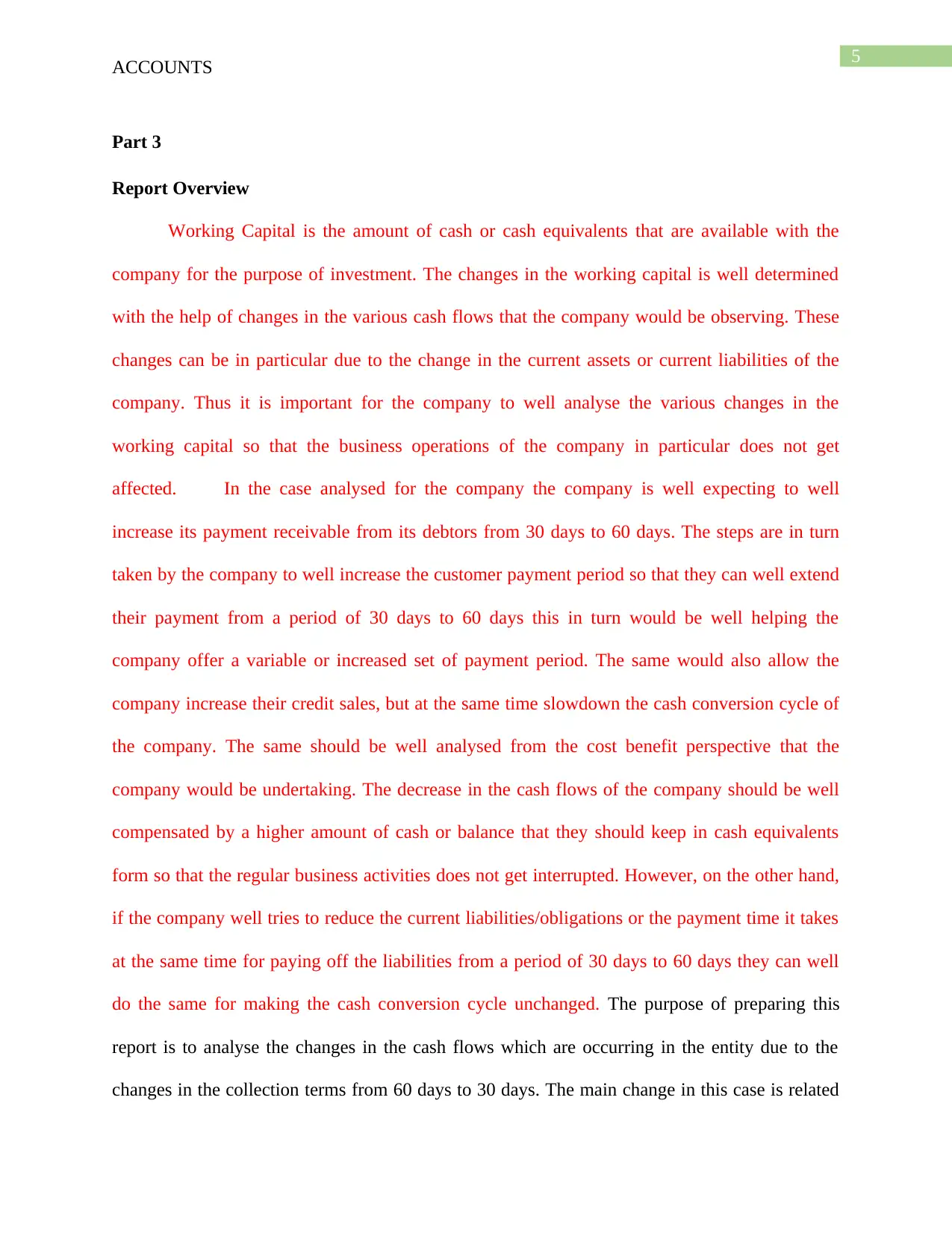
5
ACCOUNTS
Part 3
Report Overview
Working Capital is the amount of cash or cash equivalents that are available with the
company for the purpose of investment. The changes in the working capital is well determined
with the help of changes in the various cash flows that the company would be observing. These
changes can be in particular due to the change in the current assets or current liabilities of the
company. Thus it is important for the company to well analyse the various changes in the
working capital so that the business operations of the company in particular does not get
affected. In the case analysed for the company the company is well expecting to well
increase its payment receivable from its debtors from 30 days to 60 days. The steps are in turn
taken by the company to well increase the customer payment period so that they can well extend
their payment from a period of 30 days to 60 days this in turn would be well helping the
company offer a variable or increased set of payment period. The same would also allow the
company increase their credit sales, but at the same time slowdown the cash conversion cycle of
the company. The same should be well analysed from the cost benefit perspective that the
company would be undertaking. The decrease in the cash flows of the company should be well
compensated by a higher amount of cash or balance that they should keep in cash equivalents
form so that the regular business activities does not get interrupted. However, on the other hand,
if the company well tries to reduce the current liabilities/obligations or the payment time it takes
at the same time for paying off the liabilities from a period of 30 days to 60 days they can well
do the same for making the cash conversion cycle unchanged. The purpose of preparing this
report is to analyse the changes in the cash flows which are occurring in the entity due to the
changes in the collection terms from 60 days to 30 days. The main change in this case is related
ACCOUNTS
Part 3
Report Overview
Working Capital is the amount of cash or cash equivalents that are available with the
company for the purpose of investment. The changes in the working capital is well determined
with the help of changes in the various cash flows that the company would be observing. These
changes can be in particular due to the change in the current assets or current liabilities of the
company. Thus it is important for the company to well analyse the various changes in the
working capital so that the business operations of the company in particular does not get
affected. In the case analysed for the company the company is well expecting to well
increase its payment receivable from its debtors from 30 days to 60 days. The steps are in turn
taken by the company to well increase the customer payment period so that they can well extend
their payment from a period of 30 days to 60 days this in turn would be well helping the
company offer a variable or increased set of payment period. The same would also allow the
company increase their credit sales, but at the same time slowdown the cash conversion cycle of
the company. The same should be well analysed from the cost benefit perspective that the
company would be undertaking. The decrease in the cash flows of the company should be well
compensated by a higher amount of cash or balance that they should keep in cash equivalents
form so that the regular business activities does not get interrupted. However, on the other hand,
if the company well tries to reduce the current liabilities/obligations or the payment time it takes
at the same time for paying off the liabilities from a period of 30 days to 60 days they can well
do the same for making the cash conversion cycle unchanged. The purpose of preparing this
report is to analyse the changes in the cash flows which are occurring in the entity due to the
changes in the collection terms from 60 days to 30 days. The main change in this case is related
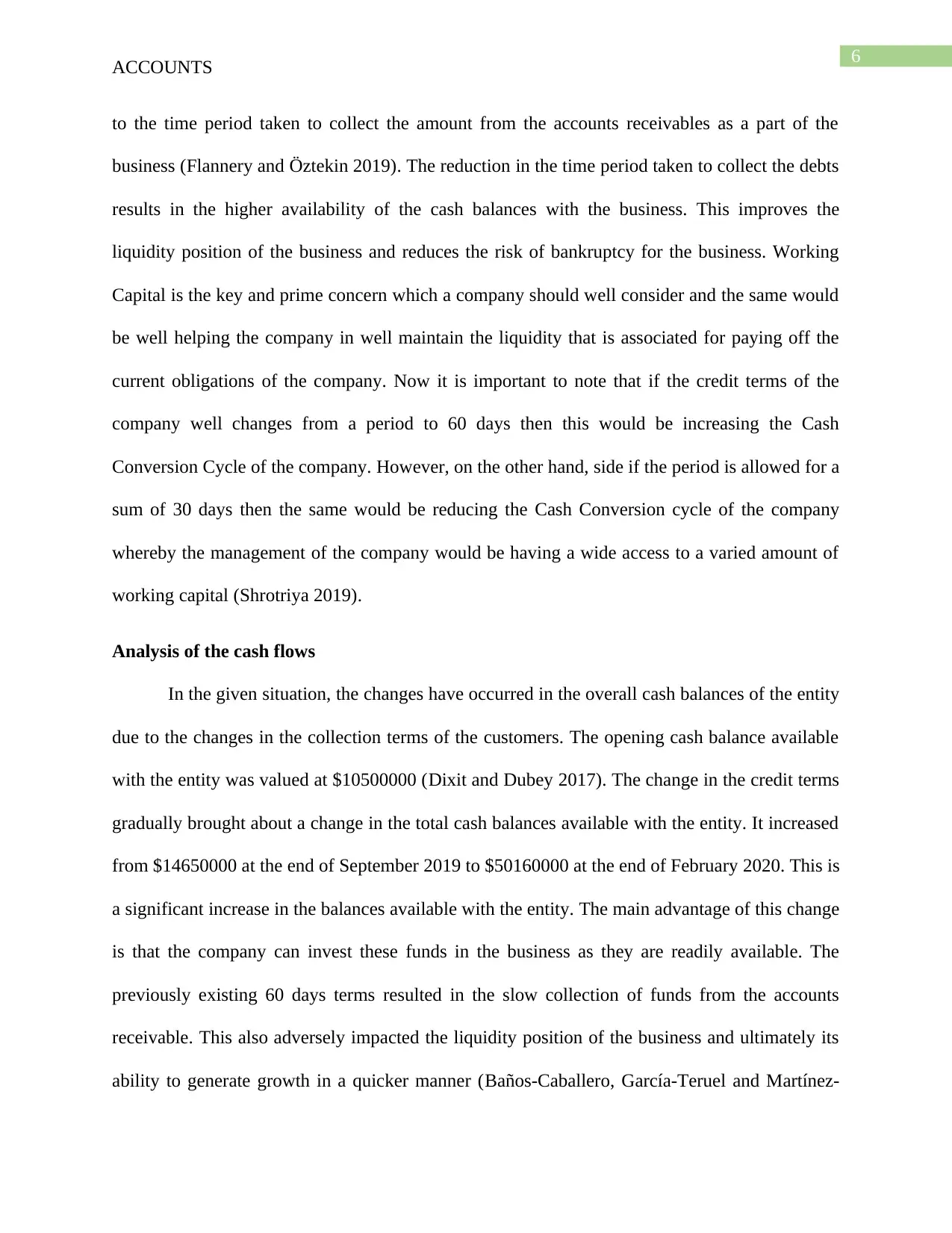
6
ACCOUNTS
to the time period taken to collect the amount from the accounts receivables as a part of the
business (Flannery and Öztekin 2019). The reduction in the time period taken to collect the debts
results in the higher availability of the cash balances with the business. This improves the
liquidity position of the business and reduces the risk of bankruptcy for the business. Working
Capital is the key and prime concern which a company should well consider and the same would
be well helping the company in well maintain the liquidity that is associated for paying off the
current obligations of the company. Now it is important to note that if the credit terms of the
company well changes from a period to 60 days then this would be increasing the Cash
Conversion Cycle of the company. However, on the other hand, side if the period is allowed for a
sum of 30 days then the same would be reducing the Cash Conversion cycle of the company
whereby the management of the company would be having a wide access to a varied amount of
working capital (Shrotriya 2019).
Analysis of the cash flows
In the given situation, the changes have occurred in the overall cash balances of the entity
due to the changes in the collection terms of the customers. The opening cash balance available
with the entity was valued at $10500000 (Dixit and Dubey 2017). The change in the credit terms
gradually brought about a change in the total cash balances available with the entity. It increased
from $14650000 at the end of September 2019 to $50160000 at the end of February 2020. This is
a significant increase in the balances available with the entity. The main advantage of this change
is that the company can invest these funds in the business as they are readily available. The
previously existing 60 days terms resulted in the slow collection of funds from the accounts
receivable. This also adversely impacted the liquidity position of the business and ultimately its
ability to generate growth in a quicker manner (Baños-Caballero, García-Teruel and Martínez-
ACCOUNTS
to the time period taken to collect the amount from the accounts receivables as a part of the
business (Flannery and Öztekin 2019). The reduction in the time period taken to collect the debts
results in the higher availability of the cash balances with the business. This improves the
liquidity position of the business and reduces the risk of bankruptcy for the business. Working
Capital is the key and prime concern which a company should well consider and the same would
be well helping the company in well maintain the liquidity that is associated for paying off the
current obligations of the company. Now it is important to note that if the credit terms of the
company well changes from a period to 60 days then this would be increasing the Cash
Conversion Cycle of the company. However, on the other hand, side if the period is allowed for a
sum of 30 days then the same would be reducing the Cash Conversion cycle of the company
whereby the management of the company would be having a wide access to a varied amount of
working capital (Shrotriya 2019).
Analysis of the cash flows
In the given situation, the changes have occurred in the overall cash balances of the entity
due to the changes in the collection terms of the customers. The opening cash balance available
with the entity was valued at $10500000 (Dixit and Dubey 2017). The change in the credit terms
gradually brought about a change in the total cash balances available with the entity. It increased
from $14650000 at the end of September 2019 to $50160000 at the end of February 2020. This is
a significant increase in the balances available with the entity. The main advantage of this change
is that the company can invest these funds in the business as they are readily available. The
previously existing 60 days terms resulted in the slow collection of funds from the accounts
receivable. This also adversely impacted the liquidity position of the business and ultimately its
ability to generate growth in a quicker manner (Baños-Caballero, García-Teruel and Martínez-
Paraphrase This Document
Need a fresh take? Get an instant paraphrase of this document with our AI Paraphraser
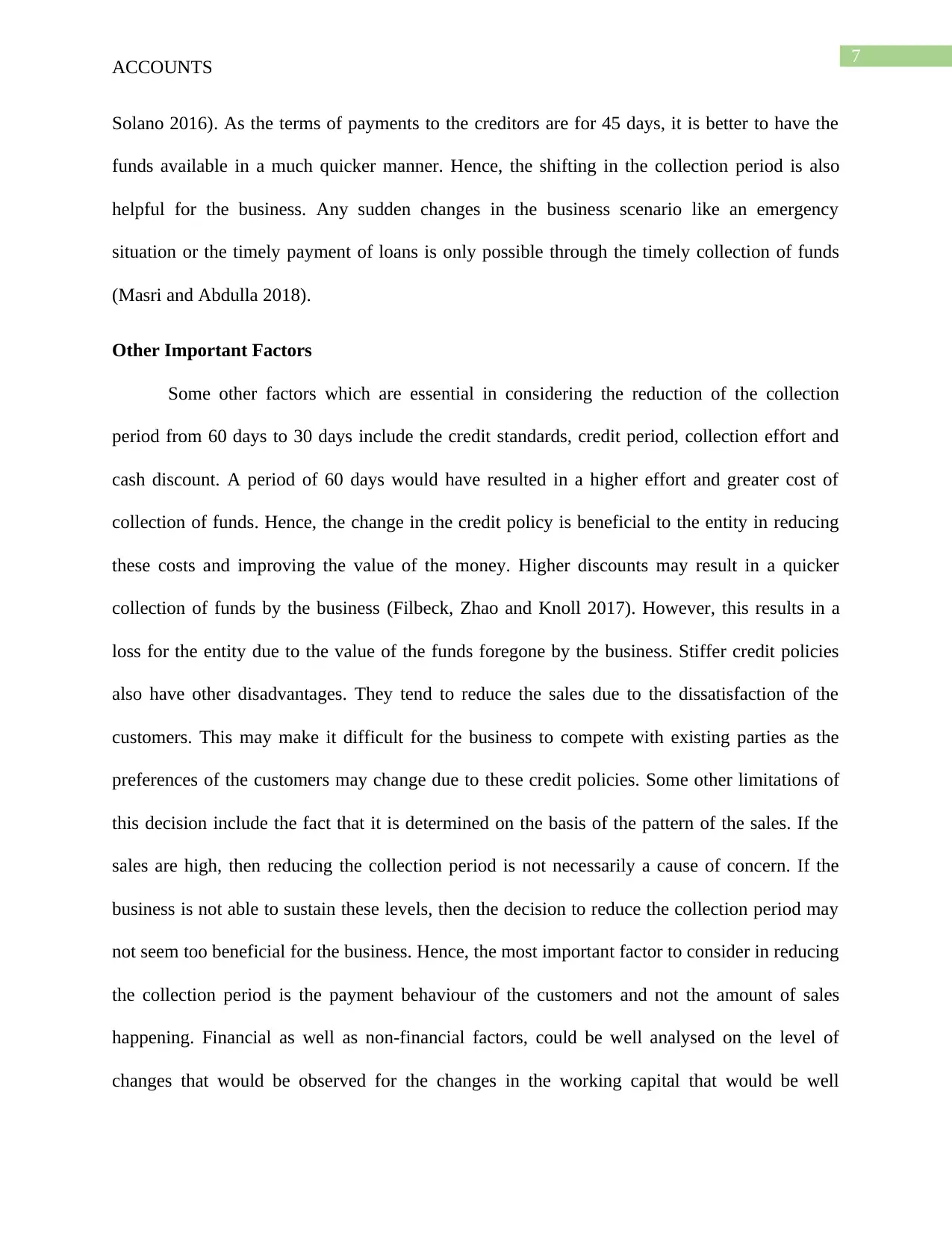
7
ACCOUNTS
Solano 2016). As the terms of payments to the creditors are for 45 days, it is better to have the
funds available in a much quicker manner. Hence, the shifting in the collection period is also
helpful for the business. Any sudden changes in the business scenario like an emergency
situation or the timely payment of loans is only possible through the timely collection of funds
(Masri and Abdulla 2018).
Other Important Factors
Some other factors which are essential in considering the reduction of the collection
period from 60 days to 30 days include the credit standards, credit period, collection effort and
cash discount. A period of 60 days would have resulted in a higher effort and greater cost of
collection of funds. Hence, the change in the credit policy is beneficial to the entity in reducing
these costs and improving the value of the money. Higher discounts may result in a quicker
collection of funds by the business (Filbeck, Zhao and Knoll 2017). However, this results in a
loss for the entity due to the value of the funds foregone by the business. Stiffer credit policies
also have other disadvantages. They tend to reduce the sales due to the dissatisfaction of the
customers. This may make it difficult for the business to compete with existing parties as the
preferences of the customers may change due to these credit policies. Some other limitations of
this decision include the fact that it is determined on the basis of the pattern of the sales. If the
sales are high, then reducing the collection period is not necessarily a cause of concern. If the
business is not able to sustain these levels, then the decision to reduce the collection period may
not seem too beneficial for the business. Hence, the most important factor to consider in reducing
the collection period is the payment behaviour of the customers and not the amount of sales
happening. Financial as well as non-financial factors, could be well analysed on the level of
changes that would be observed for the changes in the working capital that would be well
ACCOUNTS
Solano 2016). As the terms of payments to the creditors are for 45 days, it is better to have the
funds available in a much quicker manner. Hence, the shifting in the collection period is also
helpful for the business. Any sudden changes in the business scenario like an emergency
situation or the timely payment of loans is only possible through the timely collection of funds
(Masri and Abdulla 2018).
Other Important Factors
Some other factors which are essential in considering the reduction of the collection
period from 60 days to 30 days include the credit standards, credit period, collection effort and
cash discount. A period of 60 days would have resulted in a higher effort and greater cost of
collection of funds. Hence, the change in the credit policy is beneficial to the entity in reducing
these costs and improving the value of the money. Higher discounts may result in a quicker
collection of funds by the business (Filbeck, Zhao and Knoll 2017). However, this results in a
loss for the entity due to the value of the funds foregone by the business. Stiffer credit policies
also have other disadvantages. They tend to reduce the sales due to the dissatisfaction of the
customers. This may make it difficult for the business to compete with existing parties as the
preferences of the customers may change due to these credit policies. Some other limitations of
this decision include the fact that it is determined on the basis of the pattern of the sales. If the
sales are high, then reducing the collection period is not necessarily a cause of concern. If the
business is not able to sustain these levels, then the decision to reduce the collection period may
not seem too beneficial for the business. Hence, the most important factor to consider in reducing
the collection period is the payment behaviour of the customers and not the amount of sales
happening. Financial as well as non-financial factors, could be well analysed on the level of
changes that would be observed for the changes in the working capital that would be well
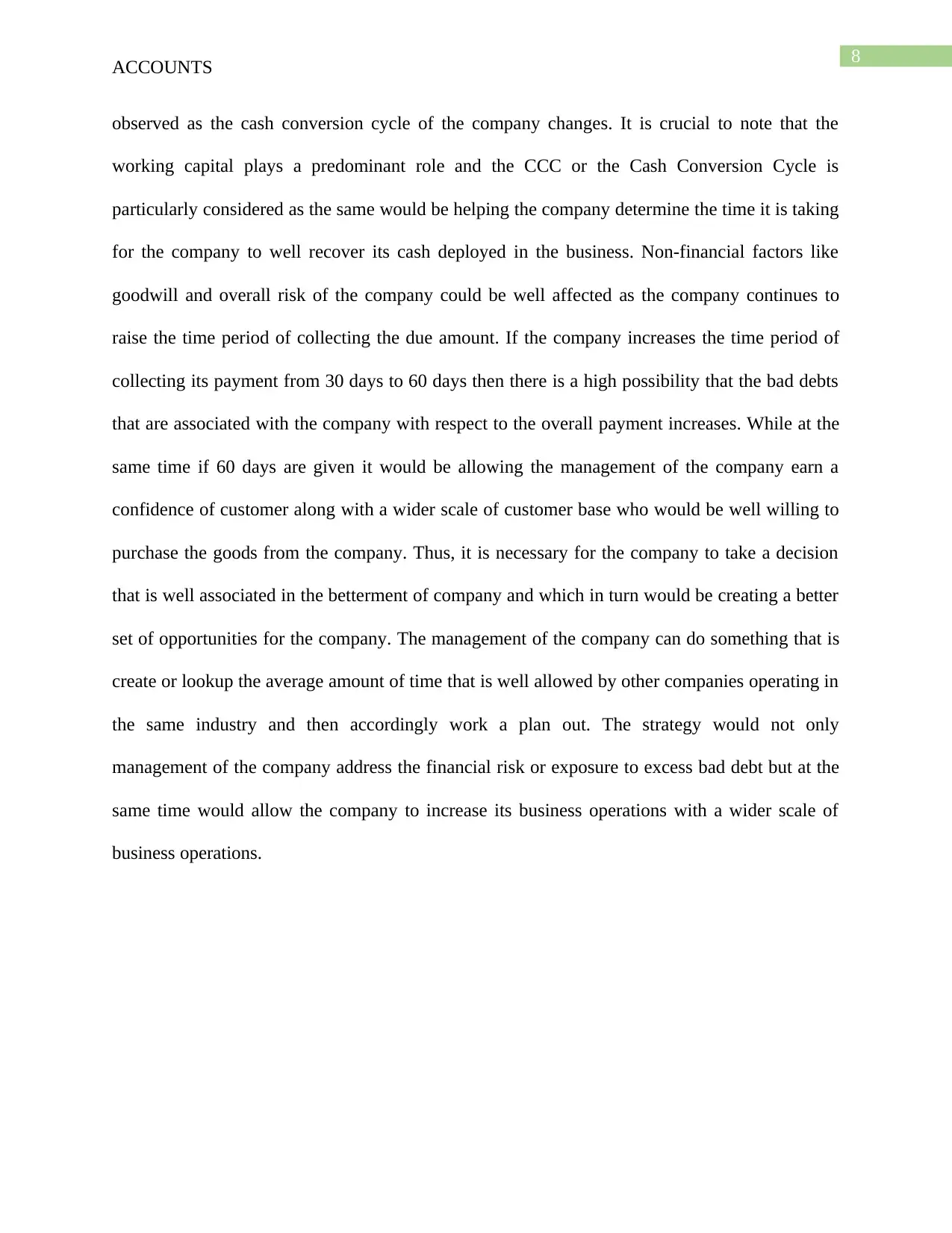
8
ACCOUNTS
observed as the cash conversion cycle of the company changes. It is crucial to note that the
working capital plays a predominant role and the CCC or the Cash Conversion Cycle is
particularly considered as the same would be helping the company determine the time it is taking
for the company to well recover its cash deployed in the business. Non-financial factors like
goodwill and overall risk of the company could be well affected as the company continues to
raise the time period of collecting the due amount. If the company increases the time period of
collecting its payment from 30 days to 60 days then there is a high possibility that the bad debts
that are associated with the company with respect to the overall payment increases. While at the
same time if 60 days are given it would be allowing the management of the company earn a
confidence of customer along with a wider scale of customer base who would be well willing to
purchase the goods from the company. Thus, it is necessary for the company to take a decision
that is well associated in the betterment of company and which in turn would be creating a better
set of opportunities for the company. The management of the company can do something that is
create or lookup the average amount of time that is well allowed by other companies operating in
the same industry and then accordingly work a plan out. The strategy would not only
management of the company address the financial risk or exposure to excess bad debt but at the
same time would allow the company to increase its business operations with a wider scale of
business operations.
ACCOUNTS
observed as the cash conversion cycle of the company changes. It is crucial to note that the
working capital plays a predominant role and the CCC or the Cash Conversion Cycle is
particularly considered as the same would be helping the company determine the time it is taking
for the company to well recover its cash deployed in the business. Non-financial factors like
goodwill and overall risk of the company could be well affected as the company continues to
raise the time period of collecting the due amount. If the company increases the time period of
collecting its payment from 30 days to 60 days then there is a high possibility that the bad debts
that are associated with the company with respect to the overall payment increases. While at the
same time if 60 days are given it would be allowing the management of the company earn a
confidence of customer along with a wider scale of customer base who would be well willing to
purchase the goods from the company. Thus, it is necessary for the company to take a decision
that is well associated in the betterment of company and which in turn would be creating a better
set of opportunities for the company. The management of the company can do something that is
create or lookup the average amount of time that is well allowed by other companies operating in
the same industry and then accordingly work a plan out. The strategy would not only
management of the company address the financial risk or exposure to excess bad debt but at the
same time would allow the company to increase its business operations with a wider scale of
business operations.
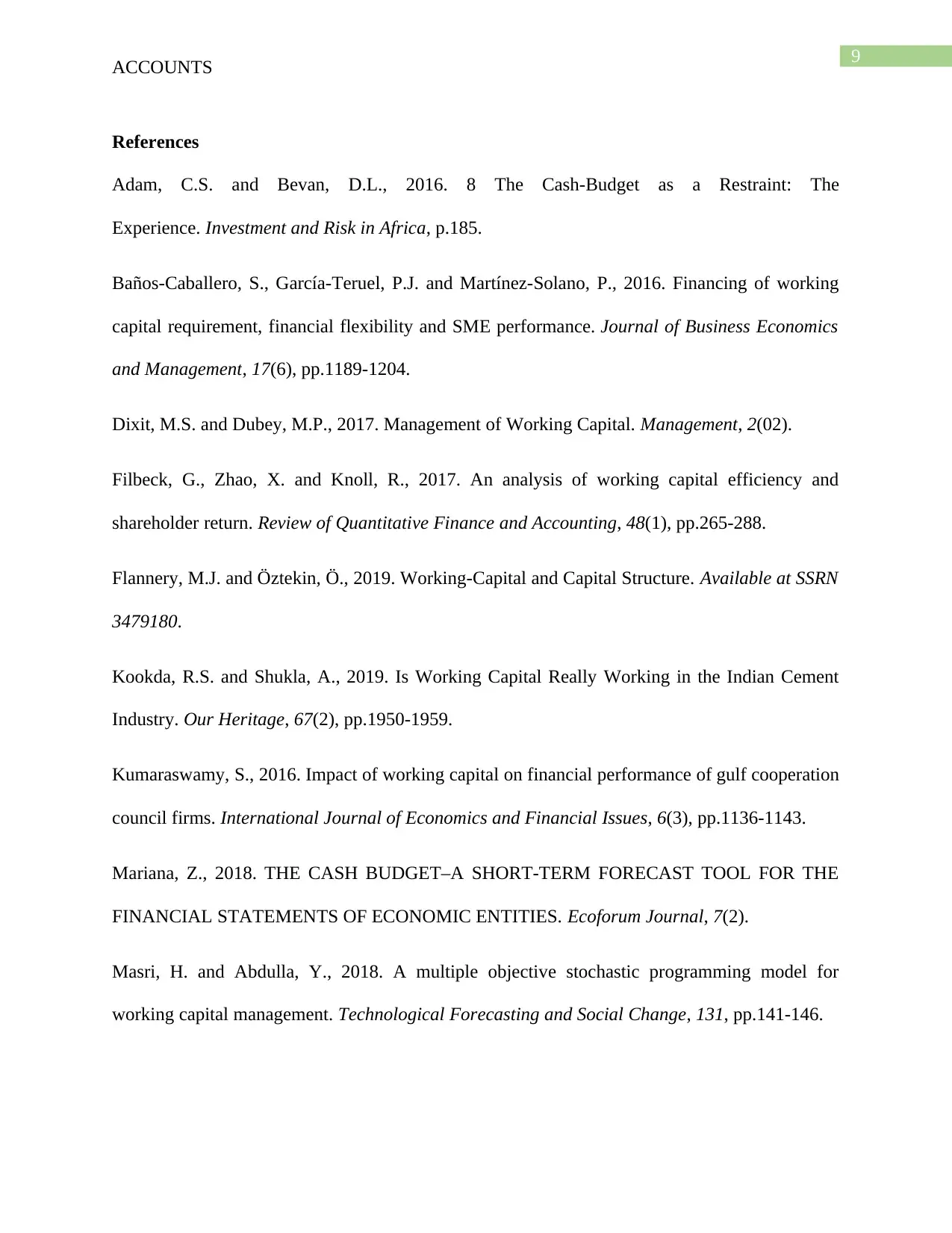
9
ACCOUNTS
References
Adam, C.S. and Bevan, D.L., 2016. 8 The Cash-Budget as a Restraint: The
Experience. Investment and Risk in Africa, p.185.
Baños-Caballero, S., García-Teruel, P.J. and Martínez-Solano, P., 2016. Financing of working
capital requirement, financial flexibility and SME performance. Journal of Business Economics
and Management, 17(6), pp.1189-1204.
Dixit, M.S. and Dubey, M.P., 2017. Management of Working Capital. Management, 2(02).
Filbeck, G., Zhao, X. and Knoll, R., 2017. An analysis of working capital efficiency and
shareholder return. Review of Quantitative Finance and Accounting, 48(1), pp.265-288.
Flannery, M.J. and Öztekin, Ö., 2019. Working-Capital and Capital Structure. Available at SSRN
3479180.
Kookda, R.S. and Shukla, A., 2019. Is Working Capital Really Working in the Indian Cement
Industry. Our Heritage, 67(2), pp.1950-1959.
Kumaraswamy, S., 2016. Impact of working capital on financial performance of gulf cooperation
council firms. International Journal of Economics and Financial Issues, 6(3), pp.1136-1143.
Mariana, Z., 2018. THE CASH BUDGET–A SHORT-TERM FORECAST TOOL FOR THE
FINANCIAL STATEMENTS OF ECONOMIC ENTITIES. Ecoforum Journal, 7(2).
Masri, H. and Abdulla, Y., 2018. A multiple objective stochastic programming model for
working capital management. Technological Forecasting and Social Change, 131, pp.141-146.
ACCOUNTS
References
Adam, C.S. and Bevan, D.L., 2016. 8 The Cash-Budget as a Restraint: The
Experience. Investment and Risk in Africa, p.185.
Baños-Caballero, S., García-Teruel, P.J. and Martínez-Solano, P., 2016. Financing of working
capital requirement, financial flexibility and SME performance. Journal of Business Economics
and Management, 17(6), pp.1189-1204.
Dixit, M.S. and Dubey, M.P., 2017. Management of Working Capital. Management, 2(02).
Filbeck, G., Zhao, X. and Knoll, R., 2017. An analysis of working capital efficiency and
shareholder return. Review of Quantitative Finance and Accounting, 48(1), pp.265-288.
Flannery, M.J. and Öztekin, Ö., 2019. Working-Capital and Capital Structure. Available at SSRN
3479180.
Kookda, R.S. and Shukla, A., 2019. Is Working Capital Really Working in the Indian Cement
Industry. Our Heritage, 67(2), pp.1950-1959.
Kumaraswamy, S., 2016. Impact of working capital on financial performance of gulf cooperation
council firms. International Journal of Economics and Financial Issues, 6(3), pp.1136-1143.
Mariana, Z., 2018. THE CASH BUDGET–A SHORT-TERM FORECAST TOOL FOR THE
FINANCIAL STATEMENTS OF ECONOMIC ENTITIES. Ecoforum Journal, 7(2).
Masri, H. and Abdulla, Y., 2018. A multiple objective stochastic programming model for
working capital management. Technological Forecasting and Social Change, 131, pp.141-146.
Secure Best Marks with AI Grader
Need help grading? Try our AI Grader for instant feedback on your assignments.
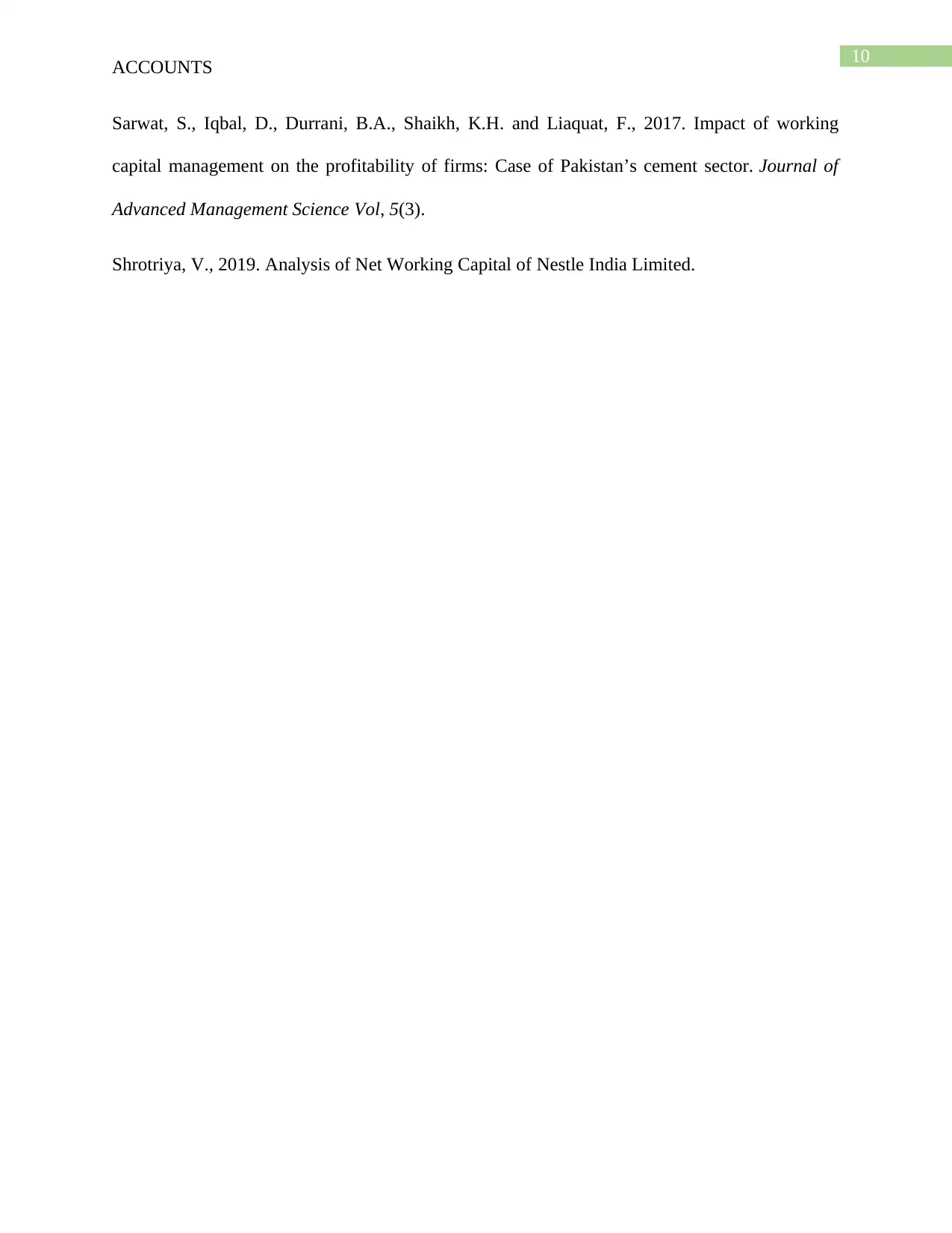
10
ACCOUNTS
Sarwat, S., Iqbal, D., Durrani, B.A., Shaikh, K.H. and Liaquat, F., 2017. Impact of working
capital management on the profitability of firms: Case of Pakistan’s cement sector. Journal of
Advanced Management Science Vol, 5(3).
Shrotriya, V., 2019. Analysis of Net Working Capital of Nestle India Limited.
ACCOUNTS
Sarwat, S., Iqbal, D., Durrani, B.A., Shaikh, K.H. and Liaquat, F., 2017. Impact of working
capital management on the profitability of firms: Case of Pakistan’s cement sector. Journal of
Advanced Management Science Vol, 5(3).
Shrotriya, V., 2019. Analysis of Net Working Capital of Nestle India Limited.
1 out of 11
Related Documents
Your All-in-One AI-Powered Toolkit for Academic Success.
+13062052269
info@desklib.com
Available 24*7 on WhatsApp / Email
![[object Object]](/_next/static/media/star-bottom.7253800d.svg)
Unlock your academic potential
© 2024 | Zucol Services PVT LTD | All rights reserved.





